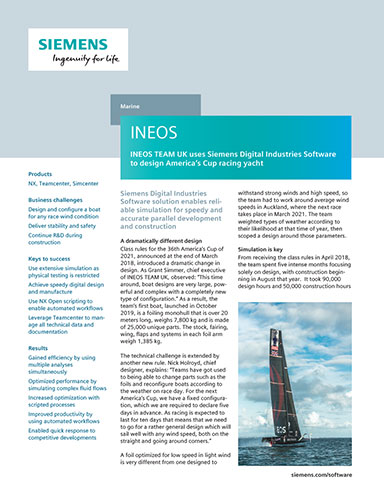
December 10, 2019
A dramatically different design Class rules for the 36th America’s Cup of 2021, announced at the end of March 2018, introduced a dramatic change in design.
As Grant Simmer, chief executive of INEOS TEAM UK, observed: “This time around, boat designs are very large, powerful and complex with a completely new type of configuration.” As a result, the team’s first boat, launched in October 2019, is a foiling monohull that is over 20 meters long, weighs 7,800 kg and is made of 25,000 unique parts. The stock, fairing, wing, flaps and systems in each foil arm weigh 1,385 kg.
The technical challenge is extended by another new rule. Nick Holroyd, chief designer, explains: “Teams have got used to being able to change parts such as the foils and reconfigure boats according to the weather on race day. For the next
America’s Cup, we have a fixed configuration, which we are required to declare five days in advance. As racing is expected to last for ten days that means that we need to go for a rather general design which will sail well with any wind speed, both on the straight and going around corners.”
A foil optimized for low speed in light wind is very different from one designed to withstand strong winds and high speed, so the team had to work around average wind speeds in Auckland, where the next race takes place in March 2021. The team weighted types of weather according to their likelihood at that time of year, then scoped a design around those parameters.
Simulation is Key
From receiving the class rules in April 2018, the team spent five intense months focusing solely on design, with construction beginning in August that year. It took 90,000 design hours and 50,000 construction hours to get the boat on the water. “We designed from scratch but we could draw on all the simulation tools and expertise that we already had in place,” comments Holroyd. Those tools include NX™, Teamcenter® and Simcenter™ software from Siemens Digital Industries Software.
Fill out the information below to download the resource.
Latest News
{if embed:display == 'small'}









